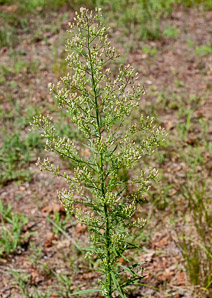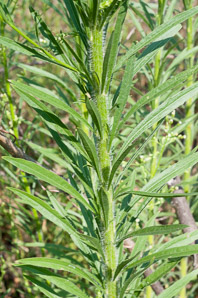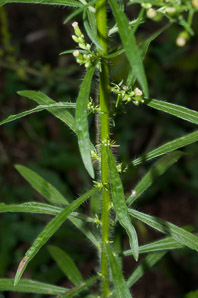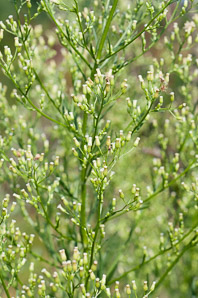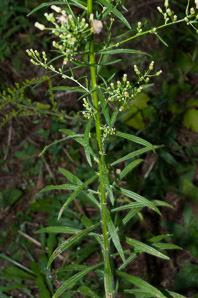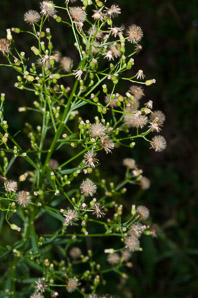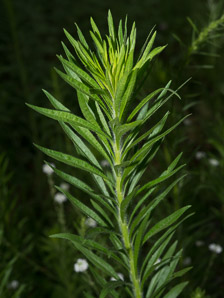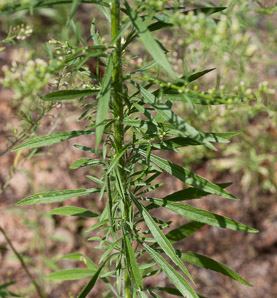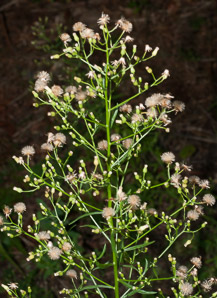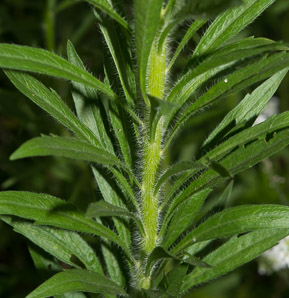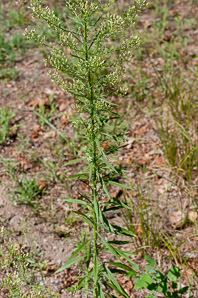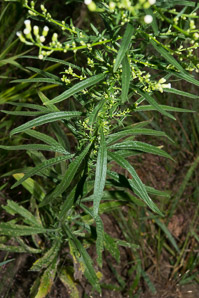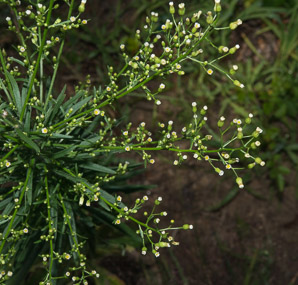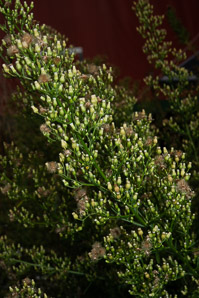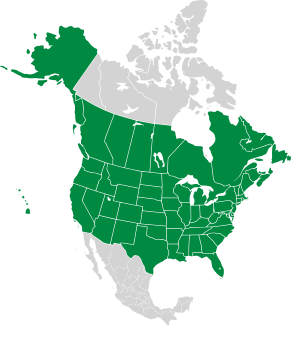
|
Conyza canadensis (L.) Cronquist Horseweed, Canada horseweed
Horseweed is a native weed that is widespread in North America, now also found in Europe, Asia, Africa, and South America. It is a serious problem in some regions, competing actively with crops. Identification: Plants are 1½-6½′ (50-200 cm) in height, with a single erect stem that has bristly hairs on it. Leaves grow alternately from the stem in a pattern that looks whorled, but isn't. They are all about the same length and orientation, making the plant resemble a green cylinder. Leaves are narrowly lanceolate or oblanceolate, 3-4″ (7.6-10 cm) × ½″ (1.3 cm). They are mostly untoothed, but have a few teeth toward their tips, and they have small white hairs along their edges. The top of the plant branches into a shape like the top of an ice cream cone, which becomes covered with a profusion of little flowers. The flowers are greenish-white, but only ⅛″ (3.2 mm) in size. They are composite flowers, producing tiny white ray flowers as well as itsy-bitsy yellow disk flowers, but their small size and coloring overall is barely noticeable. Flowers appear from June to October. Although horseweed is big and common, you are likely to overlook it completely unless it starts muscling out your vegetables—it just isn't a showy plant. Edibility: Young leaves and seedlings are edible when cooked. Dried leaves have a flavor said to be similar to that of tarragon. An oil extracted from the leaves is used as a flavoring agent. Medical: Plants produce dermatitis in some people. The common name sneezeweed derives from its use as a snuff to induce sneezing in herbal medicine, in hopes of lessening cold symptoms. Its smoke has been used as an insect repellant. Like many common plants, it has a host of other purported medical uses, among them treatment of gastrointestinal problems, rheumatism, dysentery, internal haemorrhages, gonorrhoea, and menstrual problems. Online References:
Plants for a Future, a resource and information centre for edible and otherwise useful plants 7/31/2012 · Bemis Rd Conservation Area, Pepperell, Massachusetts · ≈ 1 × 1½′ (34 × 52 cm) 8/2/2012 · Nashua River Rail Trail, near Nashoba Hospital, Ayer, Massachusetts · ≈ 6 × 9″ (14 × 22 cm) 8/20/2012 · Nashua River Rail Trail, Groton Center, Groton, Massachusetts · ≈ 3½ × 5″ (9.2 × 13 cm) 8/2/2012 · Nashua River Rail Trail, near Nashoba Hospital, Ayer, Massachusetts · ≈ 5 × 8″ (13 × 19 cm) 8/20/2012 · Nashua River Rail Trail, Groton Center, Groton, Massachusetts · ≈ 6 × 9″ (15 × 23 cm) 8/20/2012 · Nashua River Rail Trail, Groton Center, Groton, Massachusetts · ≈ 4½ × 7″ (11 × 17 cm) 8/18/2009 · Nashua River Rail Trail, Groton, Massachusetts · ≈ 12 × 17″ (29 × 44 cm) 8/17/2013 · Hopkinton State Park, Hopkinton, Massachusetts
Conyza canadensis description by Thomas H. Kent, last updated 25 May 2020. © FloraFinder.org. All rights reserved. |
7/20/2013 · Wooden Bridge, East Pepperell, Massachusetts · ≈ 7 × 11″ (18 × 28 cm) 7/31/2012 · Bemis Rd Conservation Area, Pepperell, Massachusetts · ≈ 7 × 11″ (18 × 27 cm) 8/20/2012 · Nashua River Rail Trail, Groton Center, Groton, Massachusetts · ≈ 11 × 7″ (27 × 18 cm) 7/20/2013 · Wooden Bridge, East Pepperell, Massachusetts · ≈ 8 × 12″ (21 × 31 cm) 7/20/2013 · Wooden Bridge, East Pepperell, Massachusetts · ≈ 8 × 12″ (21 × 31 cm) 7/31/2012 · Bemis Rd Conservation Area, Pepperell, Massachusetts · ≈ 1 × 1½′ (34 × 52 cm) 8/16/2013 · Nashua River Rail Trail, Groton Center, Groton, Massachusetts 8/16/2013 · Nashua River Rail Trail, Groton Center, Groton, Massachusetts 8/16/2013 · Nashua River Rail Trail, Groton Center, Groton, Massachusetts 8/22/2013 · Beaver Brook Assn Conservation Lands, Hollis, New Hampshire · ≈ 7 × 10″ (16 × 25 cm) Range:
|
